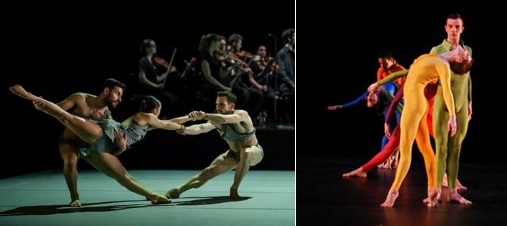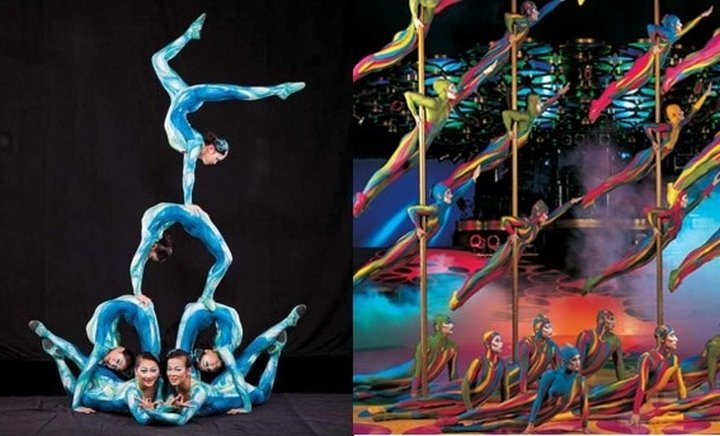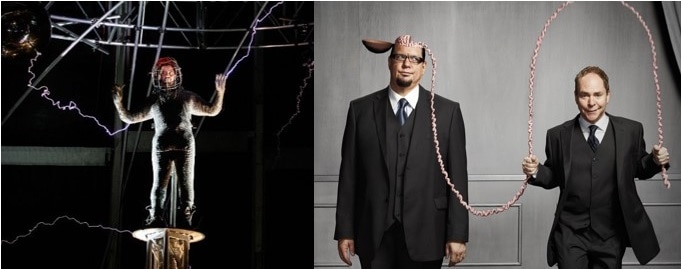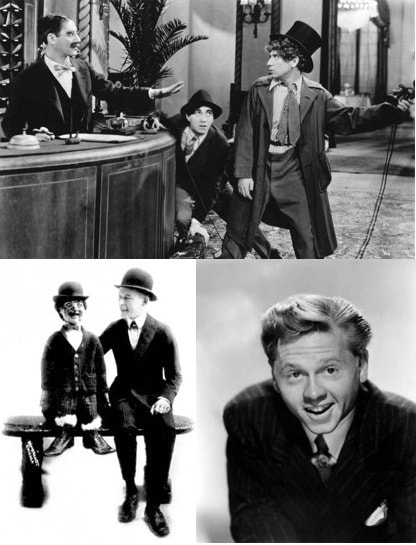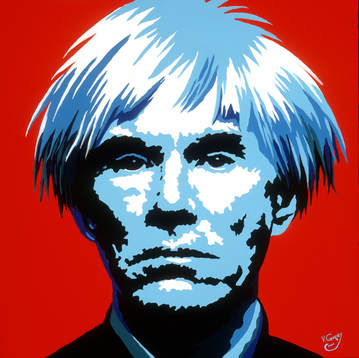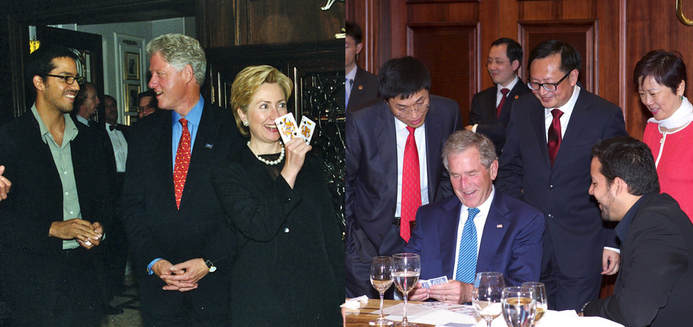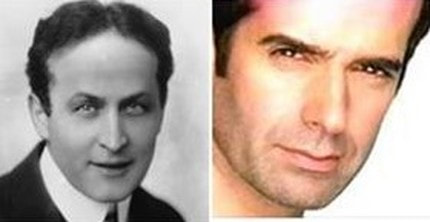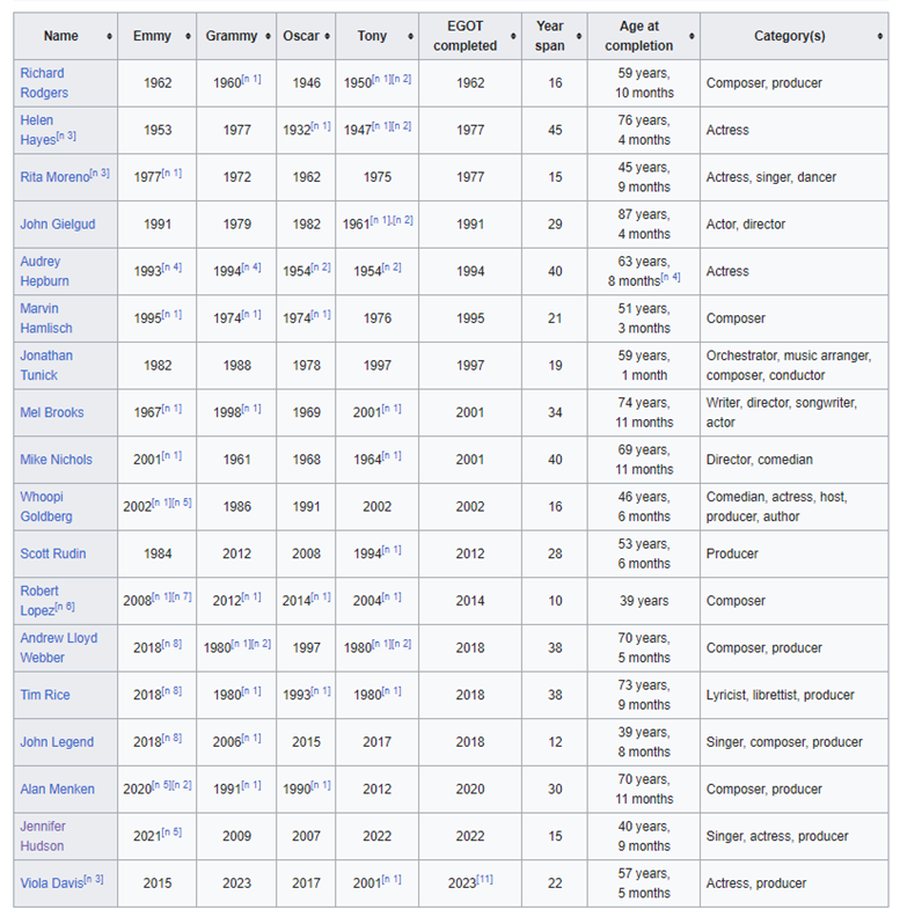Welcome to Our Generation USA!
Copyright © 2015 Bert N. Langford (Images may be subject to copyright. Please send feedback)
Entertainers
are those individuals, groups or venues with unique recognition , e.g., Ventriloquists, Illusionists, Circus or Rodeo Performers; as well as Award Programs and Other Recognition, etc.
(See other pages under this "THE GREATEST" Main Menu for other categories of Entertainers)
For amplification of each Entertainer Group, Click on Hyperlinks below.
Famous Ventriloquists in the United States
YouTube Video of Ventriloquist Sheri Lewis & Lambchop
Pictured with their puppets: Edgar Bergren and Shari Lewis.
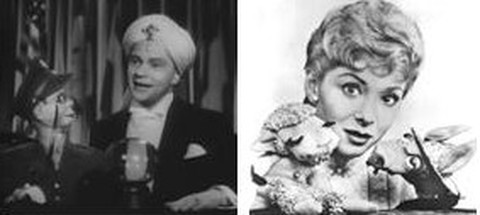
This is a list of notable ventriloquists and their best known characters. It is ordered by nationality or country in which they were notable in an alphabetical order, and then by alphabetical order of surname. It does not include voice-over artists who did not perform with a figure, or "dummy" as it is usually called.
Contortionists
YouTube: Amazing Contortionists Bend Their Way to the AGT Stage - America's Got Talent 2015
Pictured: LEFT: Example of a chest stand; RIGHT: Ravi the Scorpion Mystic standing on one leg performing his act in Times Square, NYC, 2004

Contortion (sometimes contortionism) is a performance art in which performers showcase their skills of extreme physical flexibility.
Contortion acts often accompany acrobatics, circus acts, street performers and other live performing arts. Contortion acts are typically performed in front of a live audience. An act will showcase one or more artists performing a choreographed set of moves or poses, often to music, which require extreme flexibility.
The physical flexibility required to perform such acts greatly exceeds that of the general population. It is the dramatic feats of seemingly inhuman flexibility that captivate audiences.
In some countries such as Russia and Mongolia contortion holds special cultural significance.
Contortion acts often accompany acrobatics, circus acts, street performers and other live performing arts. Contortion acts are typically performed in front of a live audience. An act will showcase one or more artists performing a choreographed set of moves or poses, often to music, which require extreme flexibility.
The physical flexibility required to perform such acts greatly exceeds that of the general population. It is the dramatic feats of seemingly inhuman flexibility that captivate audiences.
In some countries such as Russia and Mongolia contortion holds special cultural significance.
Famous Circus Performers
YouTube Video of Lions & Tigers show at Ringling Brothers Circus
Pictured: Clyde Beatty, world-renowned animal trainer, movie actor and circus owner; and Emmett Kelly, America's most famous and recognizable clown.
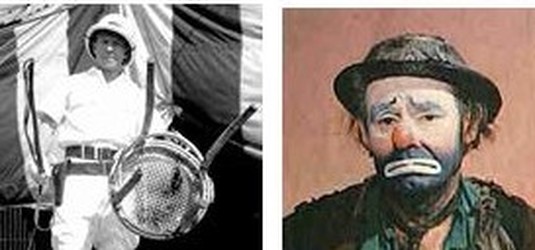
List of famous circus performers and acts both past and present, in alphabetical order.
Famous Disk Jockeys in the United States
YouTube Video of Fran Drescher on the Howard Stern Radio Show
Pictured: Dick Clark of American Bandstand & Howard Stern, the "Shock Jock".
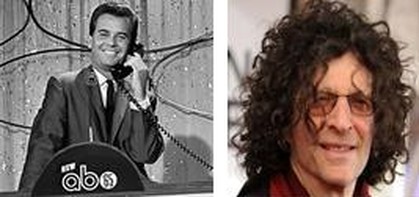
A listing of Famous Disc Jockeys including Photos, bios, and other information where available.
Judges Who Host TV Courtroom Shows
YouTube Video of Judge Judy Cracking Up When a Man Loses His Case in 26 Seconds Flat!
Pictured: Judge Judy and Judge Joe Brown.

A court show (also known as a judge show, legal/courtroom program, courtroom show, or judicial show) is a television programming subgenre of either legal dramas or reality legal programming.
Court shows present content mainly in the form of legal hearings between plaintiffs and defendants presided over by a pseudo-judge. At present, these shows typically portray small claims court cases, produced in a simulation of a small claims courtroom inside of a television studio.
Widely used techniques in court shows have been dramatizations and arbitration-based realities. The genre began with dramatizations and remained the technique of choice for roughly six decades.
By the late 1990s, however, arbitration-based realities had overwhelmingly taken over as the technique of choice within the genre, the trend continuing into the present. Dramatizations were either fictional cases (often inspired from factual details in actual cases) or reenactments of actual trials. The role of the judge was often taken by a retired real-life judge, a law school professor or an actor.
Arbitration-based realities, on the other hand, have typically involved litigants who have agreed to have their disputes aired on national television so as to be adjudicated by a television show "judge." Due to the forum merely being a simulated courtroom constructed within a television studio as opposed to a legitimate court of law, the shows' "judges" are actually arbitrators and what is depicted is a form of binding arbitration. The arbitrators presiding in modern court programs have had at least some legal experience, which is often listed as requirement by these programs.
These television programs tend to air once or twice for every weekday as part of daytime television and often cost little to create (under $200,000 a week, where entertainment magazines cost five times that).
Like talk shows, the procedure of court shows varies based upon the titular host. In most cases, they are first-run syndication programs. In 2001, the genre began to beat out soap operas in daytime television ratings.
While all syndicated shows are steadily losing audiences, court shows have the slowest rate of viewer erosion. Accordingly, by the end of the 2000s, the number of court shows in syndication had, for the first time, equaled the number of talk shows.
As reported in late 2012, court programming is the second highest-rated genre on daytime television.
The genre's most formidable competitors in syndication have been the sitcom and game show genres.
Court shows present content mainly in the form of legal hearings between plaintiffs and defendants presided over by a pseudo-judge. At present, these shows typically portray small claims court cases, produced in a simulation of a small claims courtroom inside of a television studio.
Widely used techniques in court shows have been dramatizations and arbitration-based realities. The genre began with dramatizations and remained the technique of choice for roughly six decades.
By the late 1990s, however, arbitration-based realities had overwhelmingly taken over as the technique of choice within the genre, the trend continuing into the present. Dramatizations were either fictional cases (often inspired from factual details in actual cases) or reenactments of actual trials. The role of the judge was often taken by a retired real-life judge, a law school professor or an actor.
Arbitration-based realities, on the other hand, have typically involved litigants who have agreed to have their disputes aired on national television so as to be adjudicated by a television show "judge." Due to the forum merely being a simulated courtroom constructed within a television studio as opposed to a legitimate court of law, the shows' "judges" are actually arbitrators and what is depicted is a form of binding arbitration. The arbitrators presiding in modern court programs have had at least some legal experience, which is often listed as requirement by these programs.
These television programs tend to air once or twice for every weekday as part of daytime television and often cost little to create (under $200,000 a week, where entertainment magazines cost five times that).
Like talk shows, the procedure of court shows varies based upon the titular host. In most cases, they are first-run syndication programs. In 2001, the genre began to beat out soap operas in daytime television ratings.
While all syndicated shows are steadily losing audiences, court shows have the slowest rate of viewer erosion. Accordingly, by the end of the 2000s, the number of court shows in syndication had, for the first time, equaled the number of talk shows.
As reported in late 2012, court programming is the second highest-rated genre on daytime television.
The genre's most formidable competitors in syndication have been the sitcom and game show genres.
Paparazzi at work and/or Incidents for which they were Involved.
YouTube Video of Miley Cyrus Stalked by paparazzi
Pictured: Princess Diana being hounded by the Paparazzi & Alec Baldwin attacking a Paparazzi.
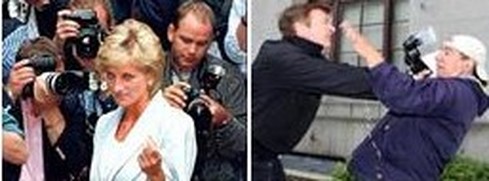
Paparazzi are independent photographers who take pictures of athletes, entertainers, politicians, and other celebrities, typically while going about their usual life routines.
Paparazzi tend to be independent contractors, unaffiliated with mainstream media organizations, and photos taken are usually done so by taking advantage of opportunities when they have sightings of high-profile people they're tracking.
Some experts have described the behavior of paparazzi as synonymous with stalking, and anti-stalking bills in many countries address the issue by reducing harassment of public figures and celebrities, especially with their minor children.
Some public figures and celebrities have expressed concern at the extent to which paparazzi go to invade their personal space. The filing and receiving of judicial support for restraining orders against paparazzi has increased, as have lawsuits with judgments against them.
Two well-known incidents are covered below:
Jacqueline Kennedy Onassis was sued by paparazzo photographer Ron Galella in 1972, after the former First Lady ordered her Secret Service agents to destroy Galella's camera and film following an encounter in New York City's Central Park.
Kennedy counter-sued claiming harassment. The trial lasted three weeks and became a groundbreaking case regarding photojournalism and the role of paparazzi. In Galella v. Onassis, Kennedy obtained a restraining order to keep Galella 150 feet (46 m) away from her and her children. The restriction later was dropped to 25 feet (7.6 m). The trial is a focal point in Smash His Camera, a 2010 documentary film by director Leon Gast.
In 1997, Diana, Princess of Wales and Dodi Fayed were killed in a limousine crash as their driver was speeding, trying to get away from paparazzi. An inquest jury investigated the involvement of paparazzi in the incident, and although several paparazzi were taken into custody, no one was convicted.
The official inquests into the accident attributed the causes to the speed and manner of driving of the Mercedes, as well as the following vehicles, and the impairment of the judgment of the Mercedes driver, Henri Paul, through alcohol.
Paparazzi tend to be independent contractors, unaffiliated with mainstream media organizations, and photos taken are usually done so by taking advantage of opportunities when they have sightings of high-profile people they're tracking.
Some experts have described the behavior of paparazzi as synonymous with stalking, and anti-stalking bills in many countries address the issue by reducing harassment of public figures and celebrities, especially with their minor children.
Some public figures and celebrities have expressed concern at the extent to which paparazzi go to invade their personal space. The filing and receiving of judicial support for restraining orders against paparazzi has increased, as have lawsuits with judgments against them.
Two well-known incidents are covered below:
Jacqueline Kennedy Onassis was sued by paparazzo photographer Ron Galella in 1972, after the former First Lady ordered her Secret Service agents to destroy Galella's camera and film following an encounter in New York City's Central Park.
Kennedy counter-sued claiming harassment. The trial lasted three weeks and became a groundbreaking case regarding photojournalism and the role of paparazzi. In Galella v. Onassis, Kennedy obtained a restraining order to keep Galella 150 feet (46 m) away from her and her children. The restriction later was dropped to 25 feet (7.6 m). The trial is a focal point in Smash His Camera, a 2010 documentary film by director Leon Gast.
In 1997, Diana, Princess of Wales and Dodi Fayed were killed in a limousine crash as their driver was speeding, trying to get away from paparazzi. An inquest jury investigated the involvement of paparazzi in the incident, and although several paparazzi were taken into custody, no one was convicted.
The official inquests into the accident attributed the causes to the speed and manner of driving of the Mercedes, as well as the following vehicles, and the impairment of the judgment of the Mercedes driver, Henri Paul, through alcohol.
Heroes & Villains
YouTube from "Silence of the Lambs"* (1991) as "Buffalo Bill Dance Goodbye Horses"
*- Silence of the Lambs Movie (1991)
Pictured: The great white shark about to devour "Quint" (Robert Shaw) in "Jaws" (1975). Sean Connery and his prized Aston Martin in "Goldfinger" (1964) from the James Bond movie franchise.

AFI's 100 Years... 100 Heroes and Villains is a list of the one-hundred greatest screen characters (fifty each in the hero and villain categories) as chosen by the American Film Institute in June 2003. It is part of the AFI 100 Years… series.
Dance and Ballet Companies including a List of Prominent Performers
YouTube Video: Pilobolus* Dance Theatre - Shadowland - Sadler's Wells is Dance
* -- Pilobolus Dance Theatre
Pictured: Dance and Ballet Performers
A dance troupe or dance company is a group of dancers and associated personnel who work together to perform dances as a spectacle or entertainment. There are many different types of dance companies, often working in different styles of dance.
A ballet company is a group of dancers who perform classical ballet, neoclassical ballet, and/or contemporary ballet in the European tradition, plus managerial and support staff.
Most major ballet companies employ dancers on a year-round basis, except in the United States, where contracts for part of the year (typically thirty or forty weeks) are the norm. A company generally has a home theatre where it stages the majority of its performances, but many companies also tour in their home country or internationally.
Click here for a List of Prominent Dance and Ballet Companies.
A ballet company is a group of dancers who perform classical ballet, neoclassical ballet, and/or contemporary ballet in the European tradition, plus managerial and support staff.
Most major ballet companies employ dancers on a year-round basis, except in the United States, where contracts for part of the year (typically thirty or forty weeks) are the norm. A company generally has a home theatre where it stages the majority of its performances, but many companies also tour in their home country or internationally.
Click here for a List of Prominent Dance and Ballet Companies.
Cirque du Soleil
YouTube Video of the Top 10 Cirque du Soleil Shows
Pictured: Two of the many acts by Cirque du Soleil
Cirque du Soleil ("Circus of the Sun") is a Canadian entertainment company. It is the largest theatrical producer in the world. Based in Montreal, Quebec, Canada, and located in the inner-city area of Saint-Michel, it was founded in Baie-Saint-Paul in 1984 by two former street performers, Guy Laliberté and Gilles Ste-Croix.
Initially named Les Échassiers ("The Waders"), they toured Quebec in 1980 as a performing troupe. Their initial financial hardship was relieved in 1983 by a government grant from the Canada Council for the Arts, as part of the 450th anniversary celebrations of Jacques Cartier's voyage to Canada.
Le Grand Tour du Cirque du Soleil was a success in 1984, and after securing a second year of funding, Laliberté hired Guy Caron from the National Circus School to re-create it as a "proper circus". Its theatrical, character-driven approach and the absence of performing animals helped define Cirque du Soleil as the contemporary circus ("nouveau cirque") that it remains today.
Each show is a synthesis of circus styles from around the world, with its own central theme and storyline. Shows employ continuous live music, with performers rather than stagehands changing the props.
After financial successes and failures in the late 1980s, Nouvelle Expérience was created – with the direction of Franco Dragone – which not only made Cirque du Soleil profitable by 1990, but allowed it to create new shows.
Cirque du Soleil expanded rapidly through the 1990s and 2000s, going from one show to 19 shows in over 271 cities on every continent except Antarctica. The shows employ approximately 4,000 people from over 40 countries and generate an estimated annual revenue exceeding US$810 million.
The multiple permanent Las Vegas shows alone play to more than 9,000 people a night, 5% of the city's visitors, adding to the 90 million people who have experienced Cirque du Soleil's shows worldwide.
In 2000, Laliberté bought out Gauthier, and with 95% ownership, has continued to expand the brand. In 2008, Laliberté split 20% of his share equally between two investment groups Istithmar World and Nakheel of Dubai, in order to further finance the company's goals.
In partnership with these two groups, Cirque du Soleil had planned to build a residency show in the United Arab Emirates in 2012 directed by Guy Caron (Dralion) and Michael Curry.
But since Dubai's financial problems in 2010 caused by the 2008 recession, it was stated by Laliberté that the project has been "put on ice" for the time being and may be looking for another financial partner to bankroll the company's future plans, even willing to give up another 10% of his share.
Several more shows are in development around the world, along with a television deal, women's clothing line and the possible venture into other mediums such as spas, restaurants and nightclubs. Cirque du Soleil also produces a small number of private and corporate events each year (past clients have been the royal family of Dubai and the 2007 Super Bowl).
The company's creations have received numerous prizes and distinctions, including:
In 2000, Cirque du Soleil was awarded the National Arts Centre Award, a companion award of the Governor General's Performing Arts Awards. In 2002, Cirque du Soleil was inducted into Canada's Walk of Fame.
In 2015, TPG Capital, Fosun Industrial Holdings and Caisse de depot et placement du Quebec purchased 90% of Cirque du Soleil. The sale received regulatory approval from the Government of Canada on 30 June 2015.
For further information about Cirque du Soleil, click on any of the following blue hyperlinks:
Initially named Les Échassiers ("The Waders"), they toured Quebec in 1980 as a performing troupe. Their initial financial hardship was relieved in 1983 by a government grant from the Canada Council for the Arts, as part of the 450th anniversary celebrations of Jacques Cartier's voyage to Canada.
Le Grand Tour du Cirque du Soleil was a success in 1984, and after securing a second year of funding, Laliberté hired Guy Caron from the National Circus School to re-create it as a "proper circus". Its theatrical, character-driven approach and the absence of performing animals helped define Cirque du Soleil as the contemporary circus ("nouveau cirque") that it remains today.
Each show is a synthesis of circus styles from around the world, with its own central theme and storyline. Shows employ continuous live music, with performers rather than stagehands changing the props.
After financial successes and failures in the late 1980s, Nouvelle Expérience was created – with the direction of Franco Dragone – which not only made Cirque du Soleil profitable by 1990, but allowed it to create new shows.
Cirque du Soleil expanded rapidly through the 1990s and 2000s, going from one show to 19 shows in over 271 cities on every continent except Antarctica. The shows employ approximately 4,000 people from over 40 countries and generate an estimated annual revenue exceeding US$810 million.
The multiple permanent Las Vegas shows alone play to more than 9,000 people a night, 5% of the city's visitors, adding to the 90 million people who have experienced Cirque du Soleil's shows worldwide.
In 2000, Laliberté bought out Gauthier, and with 95% ownership, has continued to expand the brand. In 2008, Laliberté split 20% of his share equally between two investment groups Istithmar World and Nakheel of Dubai, in order to further finance the company's goals.
In partnership with these two groups, Cirque du Soleil had planned to build a residency show in the United Arab Emirates in 2012 directed by Guy Caron (Dralion) and Michael Curry.
But since Dubai's financial problems in 2010 caused by the 2008 recession, it was stated by Laliberté that the project has been "put on ice" for the time being and may be looking for another financial partner to bankroll the company's future plans, even willing to give up another 10% of his share.
Several more shows are in development around the world, along with a television deal, women's clothing line and the possible venture into other mediums such as spas, restaurants and nightclubs. Cirque du Soleil also produces a small number of private and corporate events each year (past clients have been the royal family of Dubai and the 2007 Super Bowl).
The company's creations have received numerous prizes and distinctions, including:
- a Bambi Award in 1997,
- a Rose d'Or in 1989,
- three Drama Desk Awards in 1991, 1998 and 2013,
- three Gemini Awards,
- four Primetime Emmy Awards,
- and a star on the Hollywood Walk of Fame.
In 2000, Cirque du Soleil was awarded the National Arts Centre Award, a companion award of the Governor General's Performing Arts Awards. In 2002, Cirque du Soleil was inducted into Canada's Walk of Fame.
In 2015, TPG Capital, Fosun Industrial Holdings and Caisse de depot et placement du Quebec purchased 90% of Cirque du Soleil. The sale received regulatory approval from the Government of Canada on 30 June 2015.
For further information about Cirque du Soleil, click on any of the following blue hyperlinks:
- Origins
- Shows
- Other works
- Grand chapiteau tours
- Discography
- Filmography
- Controversies and legal issues
- Fatalities
Blue Man Group
YouTube Video: Best of Blue Man Group
Blue Man Group is a performance art company formed in 1991. It is best known for its stage productions around the world. It combines many different categories of music and art, both popular and unpopular in these shows.
Blue Man Group currently has continuing theatrical productions in Las Vegas, Orlando, Boston, Chicago, New York City and Berlin.
In addition to the stage theater show, Blue Man Group has toured the globe with multiple national and global tours; been a guest on various TV programs as both characters and performers; appeared on the Norwegian Cruise Line ship, Epic; released multiple studio albums; contributed to a number of film scores; performed with orchestras around the US, and appeared in advertising campaigns.
Blue Man Group was referenced in a storyline of the TV series Arrested Development.
Blue Man Group grew out of a collaboration between three close friends, Chris Wink, Matt Goldman and Phil Stanton, on Manhattan’s Lower East Side in 1988.
It originated as a celebration to the end of the 1980s. The three men wore blue masks and led a procession that included the burning of a Rambo doll and a piece of the Berlin Wall.
The stunt caught the attention of MTV’s Kurt Loder, who covered the event, and the strange Blue Men gained attention. The Blue Man character emerged from small "disturbances" on the streets of the city, growing into small shows at downtown clubs, eventually becoming a full performance at the Astor Place Theater in 1991.
Click on any of the following blue hyperlinks for more about the Blue Man Group:
Blue Man Group currently has continuing theatrical productions in Las Vegas, Orlando, Boston, Chicago, New York City and Berlin.
In addition to the stage theater show, Blue Man Group has toured the globe with multiple national and global tours; been a guest on various TV programs as both characters and performers; appeared on the Norwegian Cruise Line ship, Epic; released multiple studio albums; contributed to a number of film scores; performed with orchestras around the US, and appeared in advertising campaigns.
Blue Man Group was referenced in a storyline of the TV series Arrested Development.
Blue Man Group grew out of a collaboration between three close friends, Chris Wink, Matt Goldman and Phil Stanton, on Manhattan’s Lower East Side in 1988.
It originated as a celebration to the end of the 1980s. The three men wore blue masks and led a procession that included the burning of a Rambo doll and a piece of the Berlin Wall.
The stunt caught the attention of MTV’s Kurt Loder, who covered the event, and the strange Blue Men gained attention. The Blue Man character emerged from small "disturbances" on the streets of the city, growing into small shows at downtown clubs, eventually becoming a full performance at the Astor Place Theater in 1991.
Click on any of the following blue hyperlinks for more about the Blue Man Group:
- Theatrical productions
- Music and tours
- Discography
- Feature film
- Videography
- Television
- Awards and nominations
- Themes
Magician/Illusionist including a List
YouTube Video: The Best of David Blaine
YouTube Video: Penn and Teller Shock Arsenio with Their Latest Trick
Pictured: Magical Acts performed by (L) David Blaine; (R) Penn & Teller
Click Here for an Alphabetical List of Magicians Worldwide
Magic (sometimes referred to as stage or street magic to distinguish it from paranormal or ritual magic) is one of the oldest performing arts in the world in which audiences are entertained by staged tricks or illusions of seemingly impossible or supernatural feats using natural means. These feats are called magic tricks, effects, or illusions.
Click on any of the following blue hyperlinks for more about Magic:
Magic (sometimes referred to as stage or street magic to distinguish it from paranormal or ritual magic) is one of the oldest performing arts in the world in which audiences are entertained by staged tricks or illusions of seemingly impossible or supernatural feats using natural means. These feats are called magic tricks, effects, or illusions.
Click on any of the following blue hyperlinks for more about Magic:
- History
- Categories of effects
- Learning magic
- Types of magic performance
- Misuse of magic
- Researching magic
- See also:
Vaudeville
YouTube Video of "The Kid": Charlie Chaplin fight scene one of the funniest scenes in kid
Pictured:
TOP ROW: Marx Brothers
BOTTOM ROW (L-R) Fred Allen and Mickey Rooney
Vaudeville is a theatrical genre of variety show. It was especially popular in the United States and Canada from the early 1880s until the early 1930s. A typical vaudeville performance was made up of a series of separate, unrelated acts grouped together on a common bill.
Types of acts have included the following:
A vaudeville performer is often referred to as a "vaudevillian".
Vaudeville developed from many sources, including
Called "the heart of American show business", vaudeville was one of the most popular types of entertainment in North America for several decades.
The origin of the term "Vaudeville" is obscure, but is often explained as being derived from the French expression voix de ville ("voice of the city"). A second speculation is that it comes from the fifteenth-century songs on satire by poet Olivier Basselin, "Vaux de Vire".
In his Connections television series, science historian James Burke claims that the term is a corruption of the French "Vau de Vire" ("Vire River Valley", in English), an area known for its bawdy drinking songs and where Basselin lived; Jean le Houx circa 1610 collected these works as Le Livre des Chants nouveaux de Vaudevire, which is probably the direct origin of the word.
Some, however, preferred the earlier term "variety" to what manager Tony Pastor called its "sissy and Frenchified" successor. Thus, vaudeville was marketed as "variety" well into the 20th century.
Click on any of the following blue hyperlinks to learn more about Vaudeville:
Types of acts have included the following:
- popular and classical musicians,
- singers,
- dancers,
- comedians,
- trained animals,
- magicians,
- strongmen,
- female and male impersonators,
- acrobats,
- illustrated songs,
- jugglers,
- one-act plays or scenes from plays,
- athletes,
- lecturing celebrities,
- minstrels,
- and movies.
A vaudeville performer is often referred to as a "vaudevillian".
Vaudeville developed from many sources, including
- the concert saloon,
- minstrelsy,
- freak shows,
- dime museums,
- and literary American burlesque.
Called "the heart of American show business", vaudeville was one of the most popular types of entertainment in North America for several decades.
The origin of the term "Vaudeville" is obscure, but is often explained as being derived from the French expression voix de ville ("voice of the city"). A second speculation is that it comes from the fifteenth-century songs on satire by poet Olivier Basselin, "Vaux de Vire".
In his Connections television series, science historian James Burke claims that the term is a corruption of the French "Vau de Vire" ("Vire River Valley", in English), an area known for its bawdy drinking songs and where Basselin lived; Jean le Houx circa 1610 collected these works as Le Livre des Chants nouveaux de Vaudevire, which is probably the direct origin of the word.
Some, however, preferred the earlier term "variety" to what manager Tony Pastor called its "sissy and Frenchified" successor. Thus, vaudeville was marketed as "variety" well into the 20th century.
Click on any of the following blue hyperlinks to learn more about Vaudeville:
- Beginnings
- Popularity
- Selected vaudeville artists
- Immigrant America
- Decline
- Architecture
- Post-vaudeville
- Archives
- See also:
- American burlesque
- Blackface
- Borscht Belt
- Cabaret
- Chapeaugraphy
- Chautauqua
- Concert party (entertainment)
- Concert saloon
- For Me and My Gal (film)
- Music hall
- Medicine show
- Minstrel show
- Nightclub
- Revue
- Tab show
- Tivoli circuit
- Tom show
- Variety show
- Vaudeville Bellydance
- Vaudeville and Variety Collections, held in the Performing Arts Collection, Arts Centre Melbourne.
- Modern day vaudeville theatre in Austin TX
- Vaudeville Ventriloquists
- Glossary of Vaudeville Slang
- University of Washington Libraries Digital Collections – J. Willis Sayre Photographs
- University of Washington Libraries Digital Collections – Prior and Norris Troupe Photographs
- University of Washington Libraries Digital Collections - 19th Century Actors Photographs
- University of Iowa Libraries Special Collections - Keith/Albee Vaudeville Theater Collection
- Ruckus! American Entertainments at the Turn of the Twentieth Century From the collection of the Beinecke Rare Book and Manuscript Library at Yale University
- Hear Gary Stephens on Vaudeville, ICA 1988
- Illinois Digital Newspaper Collections: Vaudeville News (1920-1929)
Andy Warhol
YouTube Video about Andy Warhol
Pictured: Self Portrait by Andy Warhol
Andy Warhol (born Andrew Warhola; August 6, 1928 – February 22, 1987) was an American artist, director and producer who was a leading figure in the visual art movement known as pop art.
His works explore the relationship between artistic expression, celebrity culture, and advertising that flourished by the 1960s, and span a variety of media, including painting, silkscreening, photography, film, and sculpture.
Some of his best known works include the silkscreen paintings Campbell's Soup Cans (1962) and Marilyn Diptych (1962), the experimental film Chelsea Girls (1966), and the multimedia events known as the Exploding Plastic Inevitable (1966–67).
Born and raised in Pittsburgh, Warhol initially pursued a successful career as a commercial illustrator. After exhibiting his work in several galleries in the late 1950s, he began to receive recognition as an influential and controversial artist. His New York studio, The Factory, became a well-known gathering place that brought together distinguished intellectuals, drag queens, playwrights, Bohemian street people, Hollywood celebrities, and wealthy patrons.
He promoted a collection of personalities known as Warhol superstars, and is credited with coining the widely used expression "15 minutes of fame." In the late 1960s, he managed and produced the experimental rock band The Velvet Underground and founded Interview magazine.
He authored numerous books, including The Philosophy of Andy Warhol and Popism: The Warhol Sixties. He is also notable as a gay man who lived openly as such before the gay liberation movement. After a gallbladder surgery in 1987, Warhol died in February of that year at the age of 58.
Warhol has been the subject of numerous retrospective exhibitions, books, and feature and documentary films. The Andy Warhol Museum in his native city of Pittsburgh, which holds an extensive permanent collection of art and archives, is the largest museum in the United States dedicated to a single artist.
Many of his creations are very collectible and highly valuable. The highest price ever paid for a Warhol painting is US$105 million for a 1963 canvas titled Silver Car Crash (Double Disaster); his works include some of the most expensive paintings ever sold. A 2009 article in The Economist described Warhol as the "bellwether of the art market".
Click here for more about Andy Warhol.
His works explore the relationship between artistic expression, celebrity culture, and advertising that flourished by the 1960s, and span a variety of media, including painting, silkscreening, photography, film, and sculpture.
Some of his best known works include the silkscreen paintings Campbell's Soup Cans (1962) and Marilyn Diptych (1962), the experimental film Chelsea Girls (1966), and the multimedia events known as the Exploding Plastic Inevitable (1966–67).
Born and raised in Pittsburgh, Warhol initially pursued a successful career as a commercial illustrator. After exhibiting his work in several galleries in the late 1950s, he began to receive recognition as an influential and controversial artist. His New York studio, The Factory, became a well-known gathering place that brought together distinguished intellectuals, drag queens, playwrights, Bohemian street people, Hollywood celebrities, and wealthy patrons.
He promoted a collection of personalities known as Warhol superstars, and is credited with coining the widely used expression "15 minutes of fame." In the late 1960s, he managed and produced the experimental rock band The Velvet Underground and founded Interview magazine.
He authored numerous books, including The Philosophy of Andy Warhol and Popism: The Warhol Sixties. He is also notable as a gay man who lived openly as such before the gay liberation movement. After a gallbladder surgery in 1987, Warhol died in February of that year at the age of 58.
Warhol has been the subject of numerous retrospective exhibitions, books, and feature and documentary films. The Andy Warhol Museum in his native city of Pittsburgh, which holds an extensive permanent collection of art and archives, is the largest museum in the United States dedicated to a single artist.
Many of his creations are very collectible and highly valuable. The highest price ever paid for a Warhol painting is US$105 million for a 1963 canvas titled Silver Car Crash (Double Disaster); his works include some of the most expensive paintings ever sold. A 2009 article in The Economist described Warhol as the "bellwether of the art market".
Click here for more about Andy Warhol.
Penn & Teller
YouTube Video of Penn and Teller: "The Best Magicians in the World" - SNL
Pictured: (L) Penn; (R) Teller
Penn & Teller (Penn Jillette and Teller) are American magicians and entertainers who have performed together since the late 1970s, noted for their ongoing act which combines elements of comedy with magic.
The duo have been featured in numerous stage and television shows such as Penn & Teller: Fool Us, and are currently headlining in Las Vegas at The Rio.
Penn Jillette serves as the act's orator and raconteur. Teller, on the other hand, generally does not speak while performing, and instead communicates through mime and nonverbals, though his voice can occasionally be heard during their live shows and television appearances.
Besides magic, the pair has become associated with the advocacy of atheism, scientific skepticism, and libertarianism, particularly through their television show Penn & Teller: Bullshit!.
Click on any of the following blue hyperlinks for more about Penn & Teller:
The duo have been featured in numerous stage and television shows such as Penn & Teller: Fool Us, and are currently headlining in Las Vegas at The Rio.
Penn Jillette serves as the act's orator and raconteur. Teller, on the other hand, generally does not speak while performing, and instead communicates through mime and nonverbals, though his voice can occasionally be heard during their live shows and television appearances.
Besides magic, the pair has become associated with the advocacy of atheism, scientific skepticism, and libertarianism, particularly through their television show Penn & Teller: Bullshit!.
Click on any of the following blue hyperlinks for more about Penn & Teller:
- Career
- Off-stage relationship
- Honors
- Tricks
- Politics and personal lives
- Filmography
- Other media
- Official website
David Blaine
YouTube Video: How I held my breath for 17 minutes | David Blaine
Pictured: Blaine performs for President Bill Clinton, Secretary of State Hillary Clinton as well as President George W. Bush
David Blaine (born David Blaine White; April 4, 1973) is an American magician, illusionist and endurance artist. He is best known for his high-profile feats of endurance, and has set and broken several world records.
Blaine revolutionized the way magic is shown on television by focusing on spectator reactions. His idea was to turn the camera around on the people watching instead of the performer, to make the audience watch the audience.
The New York Times noted that "he's taken a craft that's been around for hundreds of years and done something unique and fresh with it." According to the New York Daily News, "Blaine can lay claim to his own brand of wizardry.
The magic he offers operates on an uncommonly personal level." Penn Jillette called Blaine’s first television special, Street Magic, "the biggest breakthrough (in television magic) done in our lifetime" for changing the perspective of television viewers toward those seeing the trick live.
Click on any of the following blue hyperlinks for more about David Blaine:
Blaine revolutionized the way magic is shown on television by focusing on spectator reactions. His idea was to turn the camera around on the people watching instead of the performer, to make the audience watch the audience.
The New York Times noted that "he's taken a craft that's been around for hundreds of years and done something unique and fresh with it." According to the New York Daily News, "Blaine can lay claim to his own brand of wizardry.
The magic he offers operates on an uncommonly personal level." Penn Jillette called Blaine’s first television special, Street Magic, "the biggest breakthrough (in television magic) done in our lifetime" for changing the perspective of television viewers toward those seeing the trick live.
Click on any of the following blue hyperlinks for more about David Blaine:
Famous Magicians and Illusionists
YouTube Video: David Copperfield Live performance on America's Got Talent FINALE
Pictured Below: (L) Harry Houdini (1887-1926) and (R) David Copperfield (1956-Present)
This is a comprehensive list of magicians, illusionists, mentalists, escapologists, and other practitioners of stage magic. They are presented alphabetically. Click on the starting letter "A" through "Z" below for a list of practitioners starting with that letter:
List of EGOT Winners Below is an Image of the List of EGOT Winners: Click anywhere in list to be taken to the original File in order to be able to view winners' biographies (left column in blue):
EGOT, an acronym for the Emmy, Grammy, Oscar, and Tony Awards, is the designation given to people who have won all four of the major American art awards. Respectively, these awards honor outstanding achievements in television, recording, film, and Broadway theatre. Achieving the EGOT has been referred to as the "grand slam" of show business.
As of 2023, 18 people have won a competitive EGOT, and six others have earned the distinction with honorary or special awards.
The EGOT acronym was coined by actor Philip Michael Thomas in late 1984, when his role on Miami Vice brought him instant fame, and he stated a desire to achieve the EGOT within five years.
The acronym gained wider recognition following a 2009 episode of 30 Rock that introduced EGOT status as a recurring plotline.
In 2023, TheaterMania writer Zachary Stewart criticized the practice of "selling" producer credits for shows favored to win a Tony as a "shortcut" to EGOT status. He drew a distinction between the producers who actually do the work of organizing the production of a show and investing producers who merely help finance it, often late in the award season.
Click on any of the following blue hyperlinks for more about individual EGOT Winners
EGOT winners synopsis
As of 2023, 18 people have won a competitive EGOT, and six others have earned the distinction with honorary or special awards.
The EGOT acronym was coined by actor Philip Michael Thomas in late 1984, when his role on Miami Vice brought him instant fame, and he stated a desire to achieve the EGOT within five years.
The acronym gained wider recognition following a 2009 episode of 30 Rock that introduced EGOT status as a recurring plotline.
In 2023, TheaterMania writer Zachary Stewart criticized the practice of "selling" producer credits for shows favored to win a Tony as a "shortcut" to EGOT status. He drew a distinction between the producers who actually do the work of organizing the production of a show and investing producers who merely help finance it, often late in the award season.
Click on any of the following blue hyperlinks for more about individual EGOT Winners
EGOT winners synopsis
- Richard Rodgers
- Helen Hayes
- Rita Moreno
- Sir John Gielgud
- Audrey Hepburn
- Marvin Hamlisch
- Jonathan Tunick
- Mel Brooks
- Mike Nichols
- Whoopi Goldberg
- Scott Rudin
- Robert Lopez
- Andrew Lloyd Webber
- Tim Rice
- John Legend
- Alan Menken
- Jennifer Hudson
- Viola Davis
- Three competitive awards
- Three non-competitive awards
- Four nominations
- Variations
- Equivalent honours outside the United States
